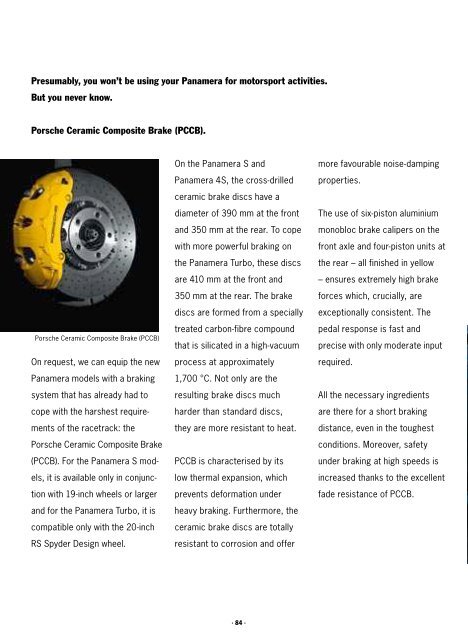The new Panamera - Mark Motors of Ottawa
The new Panamera - Mark Motors of Ottawa
The new Panamera - Mark Motors of Ottawa
You also want an ePaper? Increase the reach of your titles
YUMPU automatically turns print PDFs into web optimized ePapers that Google loves.
Presumably, you won’t be using your <strong>Panamera</strong> for motorsport activities.<br />
But you never know.<br />
Porsche Ceramic Composite Brake (PCCB).<br />
Porsche Ceramic Composite Brake (PCCB)<br />
On request, we can equip the <strong>new</strong><br />
<strong>Panamera</strong> models with a braking<br />
system that has already had to<br />
cope with the harshest requirements<br />
<strong>of</strong> the racetrack: the<br />
Porsche Ceramic Composite Brake<br />
(PCCB). For the <strong>Panamera</strong> S models,<br />
it is available only in conjunction<br />
with 19-inch wheels or larger<br />
and for the <strong>Panamera</strong> Turbo, it is<br />
compatible only with the 20-inch<br />
RS Spyder Design wheel.<br />
On the <strong>Panamera</strong> S and<br />
<strong>Panamera</strong> 4S, the cross-drilled<br />
ceramic brake discs have a<br />
diameter <strong>of</strong> 390 mm at the front<br />
and 350 mm at the rear. To cope<br />
with more powerful braking on<br />
the <strong>Panamera</strong> Turbo, these discs<br />
are 410 mm at the front and<br />
350 mm at the rear. <strong>The</strong> brake<br />
discs are formed from a specially<br />
treated carbon-fibre compound<br />
that is silicated in a high-vacuum<br />
process at approximately<br />
1,700 °C. Not only are the<br />
resulting brake discs much<br />
harder than standard discs,<br />
they are more resistant to heat.<br />
PCCB is characterised by its<br />
low thermal expansion, which<br />
prevents deformation under<br />
heavy braking. Furthermore, the<br />
ceramic brake discs are totally<br />
resistant to corrosion and <strong>of</strong>fer<br />
more favourable noise-damping<br />
properties.<br />
<strong>The</strong> use <strong>of</strong> six-piston aluminium<br />
monobloc brake calipers on the<br />
front axle and four-piston units at<br />
the rear – all finished in yellow<br />
– ensures extremely high brake<br />
forces which, crucially, are<br />
exceptionally consistent. <strong>The</strong><br />
pedal response is fast and<br />
precise with only moderate input<br />
required.<br />
All the necessary ingredients<br />
are there for a short braking<br />
distance, even in the toughest<br />
conditions. Moreover, safety<br />
under braking at high speeds is<br />
increased thanks to the excellent<br />
fade resistance <strong>of</strong> PCCB.<br />
<strong>The</strong> key advantage <strong>of</strong> PCCB is<br />
the extremely low weight <strong>of</strong> the<br />
ceramic brake discs, which are<br />
approximately 50% lighter than<br />
standard discs <strong>of</strong> similar design<br />
and size. As well as enhancing<br />
performance and fuel economy,<br />
this represents a major reduction<br />
in unsprung and rotating<br />
masses. <strong>The</strong> consequence <strong>of</strong><br />
this is better road holding and<br />
increased comfort, particularly<br />
on uneven roads, as well as<br />
greater agility and improved<br />
handling.<br />
Please note that circuit racing,<br />
track day use and other forms<br />
<strong>of</strong> performance driving can<br />
significantly reduce the service<br />
life <strong>of</strong> even the most durable<br />
brake pads and discs. As with<br />
conventional high-performance<br />
braking systems, we recommend<br />
that all brake components<br />
be pr<strong>of</strong>essionally inspected and<br />
· 84 · · 85 ·<br />
Balance | Safety<br />
replaced where necessary after<br />
every track event.



